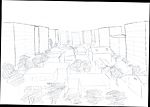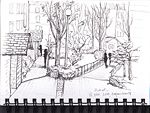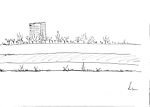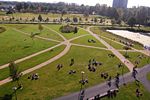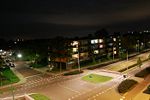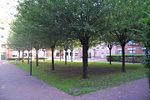Windowscape
---> back to overview of Case Study List
Everyday landscape: view from the window
| Name | Windowscape | |
| Location | Wageningen | |
| Country | The Netherlands | |
| Author | Oana Baloi | |

| ||
| <googlemap version="0.9" lat="38.694621" lon="1.471481" type="satellite" zoom="11" width="300" height="250">
<> | ||
Short Introduction to the Area of Study
Wageningen is a small city within The Netherlands with fast increasing number of inhabitants due to the presence of academic and research activity in the domains of life science. Everyday landscape relates to land usage and planning, in relation to spatial issues of daily activities of the inhabitants. Every space has its own story. Living a story through landscape gather the human perception over the landscape from the early morning landscape seen on the dorm window, to the view from the offices windows, and nevertheless, the landscape in between. The present study aims to gain knowledge about the human perception over the landscape by investigating the meaning of landscape seen in the window frame of their everyday activities. The specific research questions include the usage, perception and engagement of different people to their everyday landscape. The subject interact with the functions of a sustainable urban plan, assessing the landscape for the comfort of inhabitants. Therefore, the study represents a research over the reasonable and comfortable everyday landscape, from the point of view of the users.
Exercise 1: Sketching the Landscape
Time frame: October 25 - November 15, 2011
Student activities:
- Creation of analytical drawings and sketches
- Presentation of results
The most often appreciated painting is the painting we see everyday in the frame of our window. Forever changing in colors and characters, the windowscape may differ in preference, in perception and in importance for the owner. Though the view on the window directly influences the economic income in real estate development, the preference for window landscape is sometimes limited by architectural objects, living facilities and urban development landscapes without considering the importance of the windowscape. The view from the window is an issue frequently neglected in contemporary urban development. The sketches presented illustrates the widowscapes of different persons, made by them self. The interpretation of the landscape that we see everyday is constantly influenced by the way we perceive the outdoor elements that build everyday experience. For instance a massive architectural front dominating the horizon gives enclosure and limitation to the perceiver, feeling translated very clear in the sketches. However, the dominance of the nature seems to be more important in human size appreciation, while from the tower living blocks, the flat land of The Netherlands seems to smash to the ground the nature together with the architecture. Particularly in Wageningen, the layer approach to the landscape is easily understood in everyday living experience. The coherence and legibility of the landscape makes it easy to be decoded by ordinary people. The coherence and legibility of the landscape makes it easy to be decoded by ordinary people. The layers of circulation, water and vegetation are coherent, with a strong accent on functionality of the spaces. The most important element is familiarity and attachment for certain views, for example large openings, or dense vegetation. Also preferences of interviewed people include the presence of light and sun as important in describing their everyday landscape. Environmental and physic elements have their own influence in building the “home” space outside the window.
“Wherever I move, it seems that I always have a tree outside my window. I like that ..” (quote: a facebook status) The particularities of the view outside the window influence our preference and our attachment for a certain landscape. The windowscape is important both for inhabitants and for real estate developers.
Please upload a selection of your drawings/sketches/mental maps and add them to the image gallery
- IMG 5295.JPG
My everyday window-landscape
- Wageningen textures.jpg
through its details
Exercise 2: Landscape Layers
Time frame: November 15 - 29, 2011
- time based changes and 'landscape biography', and/or:
- topography, open spaces, built, green, traffic and water structures on different layers. *Definition of zones with coherent character
- Description of this character.
- Presentation-Wageningen---map.jpg
your image text
- Yourimagename.jpg
your image text
- Yourimagename.jpg
your image text
- Yourimagename.jpg
your image text
- Yourimagename.jpg
your image text
Please publish your findings here
Exercise 3: Behaviour Patterns
Time frame: December 6 - 20, 2011
- How do people behave in this area? How do they use the space? What is important for them?
- Observation of study area, interviews with local people and mapping of use patterns.
- Preparation of short presentation
- Yourimagename.jpg
your image text
- Yourimagename.jpg
your image text
- Yourimagename.jpg
your image text
- Yourimagename.jpg
your image text
- Yourimagename.jpg
your image text
Please publish your findings here
Exercise 4: Communication Concepts
Time frame: December 19, 2011 - January 17, 2012
- Based on the different landscape assessment approaches students will develop a communication concept for their area of study
- Which measures would be necessary for enhancing the awareness for the area?
- Students are free to choose their method.
- Yourimagename.jpg
your image text
- Yourimagename.jpg
your image text
- Yourimagename.jpg
your image text
- Yourimagename.jpg
your image text
- Yourimagename.jpg
your image text
Please publish your findings here
Image Gallery
- Yourimagename.jpg
your image text
- Yourimagename.jpg
your image text
- Yourimagename.jpg
your image text
- Yourimagename.jpg
your image text
- Yourimagename.jpg
your image text
References
* Please make sure that you give proper references of all external resources used.
* Do not use images of which you do not hold the copyright.
* Please add internet links to other resources if necessary.
About categories: You can add more categories with this tag: "", add your categories

